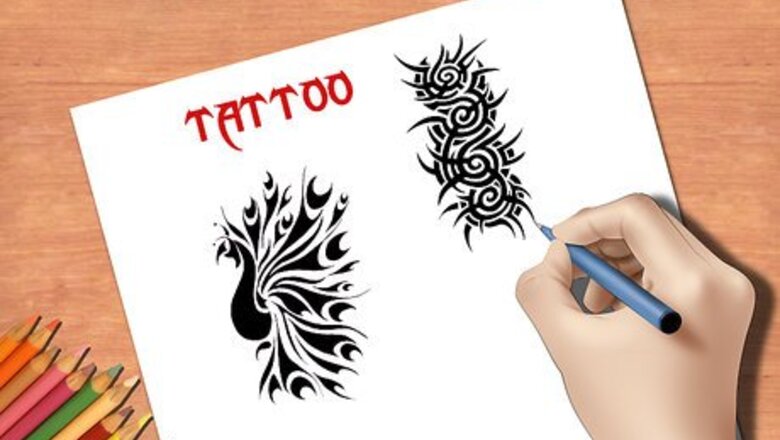
views
Training Your Drawing Skills for Tattooing
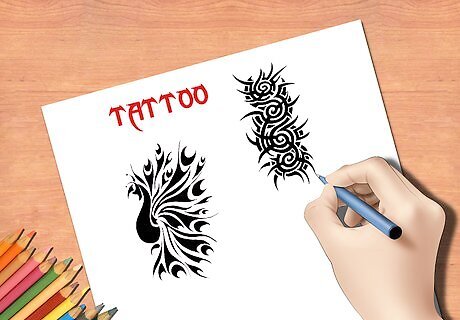
Draw constantly. As a professional tattoo artist, you'll be expected to sketch out, sometimes start to finish, the designs your clients want. This will require you to be skillful at reproducing many different kinds of styles, which can only really be mastered through experience and repetition. Collect designs you like and practice recreating them. Tattoo artists often have to borrow from the designs of others, and this is a great way to get used to it! Work on transitioning from pencil to pen, which has a more permanent feel.
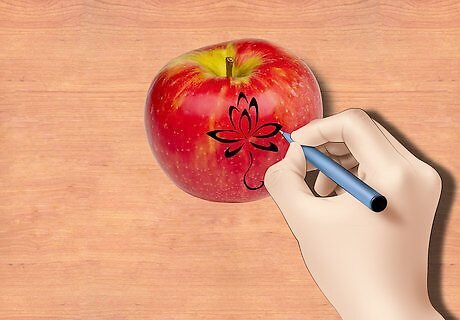
Draw on contoured objects. Apples, oranges, and other contoured items, like rocks, can simulate some of the difficulties you'll have tattooing various parts of the body. Seek out items that somewhat resemble body parts commonly tattooed, so that you're well prepared when someone requests a tattoo on a more curvaceous part of the body. Alternatively, draw your designs at an angle, so they're in a certain perspective.

Test your tattooist skills with a non-toxic marker and a friend. Though the experience of drawing on a person's body is markedly different from operating a tattoo machine and depositing ink into the skin, this practice will get you accustomed to drawing on a living canvas and various body parts. You might even seek out your more ticklish friends so that you have experience with a squirming client. Ask them for what they want and then practice crafting your own designs for them. See if they like what you come up with! This is what tattoo artists do every day.
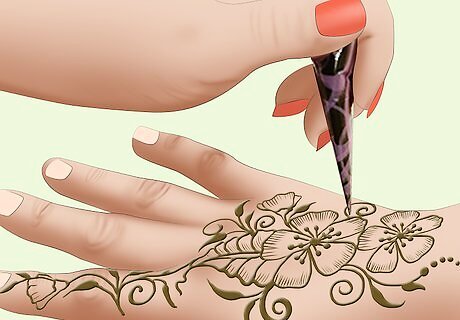
Use henna to learn how to apply designs to the contours of the body. Henna is a kind of traditional dye that has been used since ancient times. It is relatively inexpensive, can be bought online or at many general retailers and pharmacies. Due to the fact that henna remains on the skin for several days, you might want to hold off trying this until you're somewhat practiced on inanimate objects. Then, following the directions on the package: Mix your henna dye and collect the applicator for your henna. Apply it to the skin of your practice subject in the design desired. Note any improvements that could be made and ask for feedback.
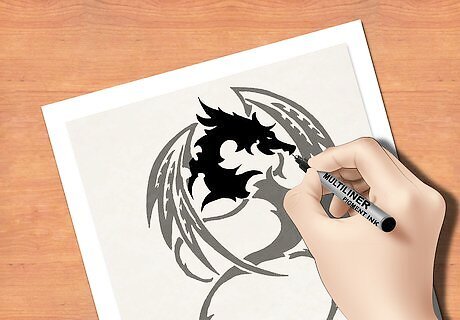
Train yourself in inking lines and tracing. Many professional tattooists first began learning the art by tracing sample tattoos and simplifying designs to be more translatable to the skin. This skill can be imitated and studied academically by enrolling in a class in Inking, which is the practice of outlining and interpreting an original pencil drawing.
Becoming Familiar with the Equipment
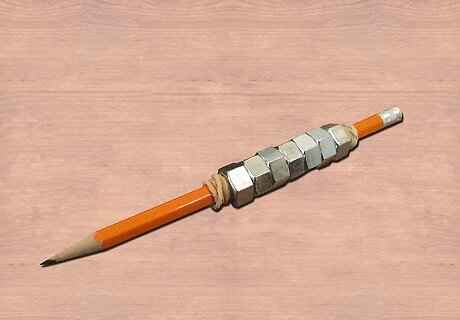
Use a weighted pencil or pen to simulate the tattooing machine. Some tattooists recommend building hand strength by simulating the weight of the tattoo machine applicator. This machine uses an applicator heavier than a pen or pencil to drive ink into the sub-layers of the skin, leaving behind permanent skin art. You may want to start your weighted practice by attaching about 80 grams (3 ounces) to a drawing utensil.
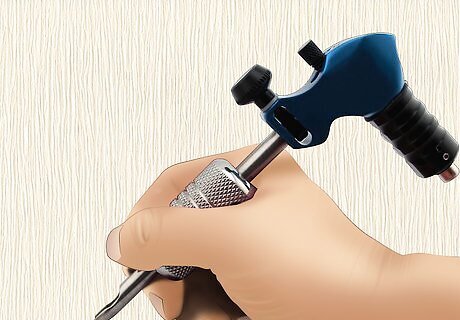
Purchase a cheap tattoo machine for practice. This will provide you with a way to become comfortable with the machine. Beyond understanding how its working parts operate, how to replace failed parts, and how to assess the working condition of a tattoo machine, you'll also have to become comfortable with holding the applicator for long periods of time. If you're doing an apprenticeship, your mentor may have a machine for you to practice on. You might also rig a pencil to your tattoo machine and practice drawing. This way you'll develop comfort and familiarity with machine and clip cord. While a cheap machine is great for personal practice, don't use your practice machine on clients.
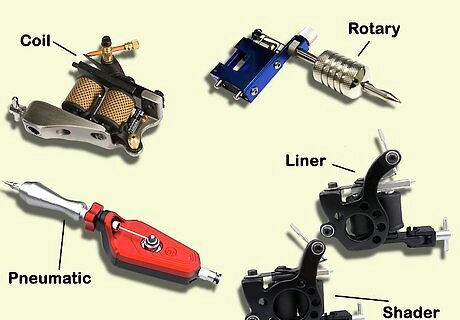
Learn the different kinds of tattoo machines. There are many different tattoo machines on the market, though coil tattoo machines are the most commonly used variety. Certain machines are used to accomplish certain effects, like shading and coloring. Altogether, you should be familiar with: Coil tattoo machines Rotary tattoo machines Pneumatic tattoo machines Shader tattoo machines Liner tattoo machines
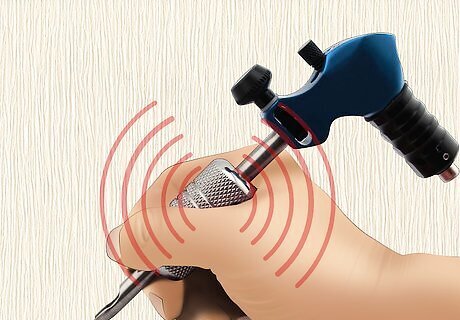
Learn to compensate for the vibration of your tattoo machine. The force of your machine operating will cause an intense vibration that you may feel through your entire arm. Be prepared for this when you turn on your machine, dip your nip in ink, and train your hand to be steady.
Practicing with a Tattoo Machine
Watch a professional use a machine first. Observe a professional set up their machine and the equipment as well as how they prep their client. When they begin tattooing, watch how the artist holds and angles the machine and pay attention to how much pressure they're applying. You can even watch YouTube videos if you want more practice.

Practice on fruit. Fruits have a challenging contour that will mimic the clients that sit in your chair for a tattoo, and are cheaper and more readily available than other options. Some fruits that you should consider for tattooing practice: Bananas Melons Grapefruits
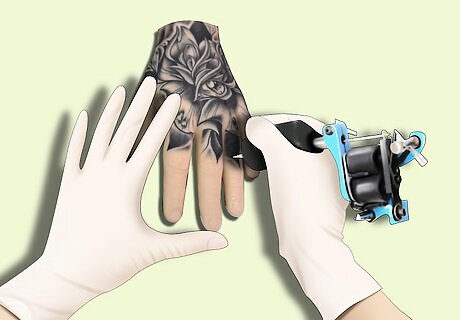
Consider synthetic skin. Synthetic skin is a relatively new comer to the tattooing scene. Practice skin is relatively easy to order from online sources, but many tattooists criticize this false skin as too far from the real thing. Synthetic skin can: Be useful for starting out and getting a feel for your tattoo machine. Provide you with practice for building your hand strength.

Purchase pig skin for a realistic practice experience. Pig skin is a close approximation of human skin, and can give you a more realistic trial run than you would experience with fruit or synthetic skin. Pig skin is also the traditional practice medium used by tattoo apprentices, and due to its similarity to human skin, will train you to have better control with the depth of your needle. Pig skin can be bought expressly for the purposes of tattooing online, but as many butchers end up throwing it out, you might find a cheaper more plentiful alternative at your local butcher.
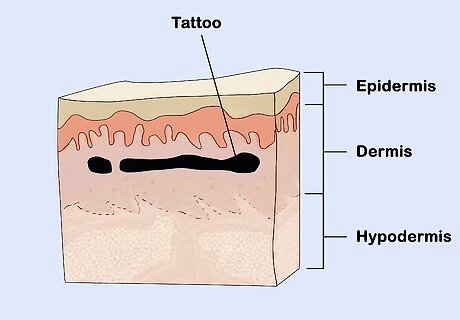
Tattoo to the correct depth. Human skin is comprised of 3 layers, with some of these layers have sub-layers. The top layer of your skin, the epidermis, is made up of a total of 5 layers which grow outward, which means ink deposited in the epidermis will eventually fade. Your target depth when tattooing should be the middle layer, the dermis, which is between 1-2 mm beneath the skin. Going to deep into the skin with your tattoo machine can lead to unnecessary pain for your client, and a possible risk of infection.
Give yourself a tattoo. Before you work on another person, tattoo your own skin so you can see how it feels and how deep to insert the needle. You will also learn about caring for the tattoo and how long it takes to heal, which is important information you can share with your clients. Next, try giving out free tattoos to clients. Many people are willing to get a tattoo for free from a novice so you can get some experience.














Comments
0 comment